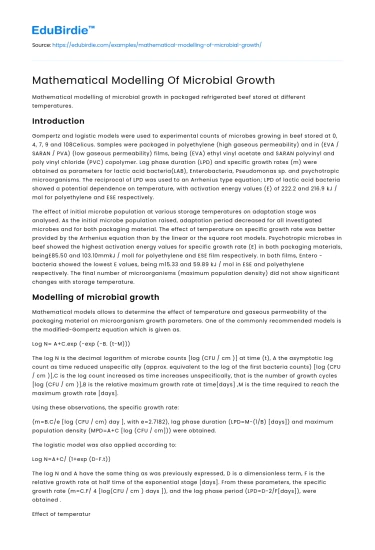Mathematical modelling of microbial growth in packaged refrigerated beef stored at different temperatures.
Introduction
Gompertz and logistic models were used to experimental counts of microbes growing in beef stored at 0, 4, 7, 9 and 108Celicus. Samples were packaged in polyethylene (high gaseous permeability) and in (EVA / SARAN / PVA) (low gaseous permeability) films, being (EVA) ethyl vinyl acetate and SARAN polyvinyl and poly vinyl chloride (PVC) copolymer. Lag phase duration (LPD) and specific growth rates (m) were obtained as parameters for lactic acid bacteria(LAB), Enterobacteria, Pseudomonas sp. and psychotropic microorganisms. The reciprocal of LPD was used to an Arrhenius type equation; LPD of lactic acid bacteria showed a potential dependence on temperature, with activation energy values (E) of 222.2 and 216.9 kJ / mol for polyethylene and ESE respectively.
Save your time!
We can take care of your essay
- Proper editing and formatting
- Free revision, title page, and bibliography
- Flexible prices and money-back guarantee
The effect of initial microbe population at various storage temperatures on adaptation stage was analysed. As the initial microbe population raised, adaptation period decreased for all investigated microbes and for both packaging material. The effect of temperature on specific growth rate was better provided by the Arrhenius equation than by the linear or the square root models. Psychotropic microbes in beef showed the highest activation energy values for specific growth rate (E) in both packaging materials, beingE85.50 and 103.10mmkJ / moll for polyethylene and ESE film respectively. In both films, Entero -bacteria showed the lowest E values, being m15.33 and 59.89 kJ / mol in ESE and polyethylene respectively. The final number of microorganisms (maximum population density) did not show significant changes with storage temperature.
Modelling of microbial growth
Mathematical models allows to determine the effect of temperature and gaseous permeability of the packaging material on microorganism growth parameters. One of the commonly recommended models is the modified-Gompertz equation which is given as.
Log N= A+C.exp (-exp (-B. (t-M)))
The log N is the decimal logarithm of microbe counts [log (CFU / cm )] at time (t), A the asymptotic log count as time reduced unspecific ally (approx. equivalent to the log of the first bacteria counts) [log (CFU / cm )],C is the log count increased as time increases unspecifically, that is the number of growth cycles [log (CFU / cm )],B is the relative maximum growth rate at time[days] ,M is the time required to reach the maximum growth rate [days].
Using these observations, the specific growth rate:
(m=B.C/e [log (CFU / cm) day ], with e=2.7182), lag phase duration (LPD=M-(1/B) [days]) and maximum population density (MPD=A+C [log (CFU / cm])) were obtained.
The logistic model was also applied according to:
Log N=A+C/ (1+exp (D-F.t))
The log N and A have the same thing as was previously expressed, D is a dimensionless term, F is the relative growth rate at half time of the exponential stage [days]. From these parameters, the specific growth rate (m=C.F/ 4 [log(CFU / cm ) days ]), and the lag phase period (LPD=D-2/F[days]), were obtained .
Effect of temperature on lag phase duration:
Adaptation rate of microbes termed as the inverse of lag phase (1 / LPD) was fitted to an Arrhenius type equation
1 / LPD=Z exp. (-E LPD/RT)
Effect of temperature on specific growth rate:
Effect of storage temperature (0, 4, 7, 9 and 108C) on specific growth rate (m) was described by the following equations:
a) Arrhenius model:
M=A’.exp(-Em /RT)
where m is the specific growth rate [log(CFU / cm )day ], T the absolute temperature, E is the activation energy [kJ / mol],A’ is the pre exponential factor [log(CFU / cm ) days ], and R is the gas constant.
b) Linear model:
M=mo+RT
Where m is the specific growth rate at 0 degree Celsius [log(CFU / cm ) days ],T is the temperature in (C),ris2slope of the linear regression [log(CFU / cm) day Celsius ].
c) Square root equation:
The square root equation is usually the most experimented and widely used model to analyse the effect of temperature on specific microbial growth rate. Ratkowsky. Proposed the following relationship:
=g. (T’-T0’)
where g is a regression coefficient [(log(CFU / cm )is the incubation absolute temperature-adaptation period for psychotropic microbes, T is the conceptual temperature with no metabolic importance for psychrophilic, psychrotrophs and mesophils.
Refrences:
- Giannuzzi, L., Pinotti, A., & Zaritzky, N. (1998).
- International Journal of Food Microbiology (2000)






 Stuck on your essay?
Stuck on your essay?

